|
A lot has been written about Lockheed's
venerable P-38 Lightning. It was one of the most frightening sights and sounds in
the skies of Europe and the south Pacific during World War II. Frightening for Axis
power fighters, that was. For the Allies, it was one of the most comforting. Like
most military aircraft built in the era, their airframes and engines were not designed
to last for more than a few years. So surviving examples of these airplanes are
both rare and expensive to procure and to own. For the vast majority of people -
myself included - the closest we can ever hope to get is a flying scale model. Here
is a little more information to add to your collection of trivia and photos of the
P-38 Lightning. The incredible Bjorn Karlström provided the 4-view drawing. The P-38 - Best of the Twins
Don BerlinerAlthough all of the WW II twin-engined fighters
left something to be desired, the Lockheed lightning did just about everything a
military airplane could do.
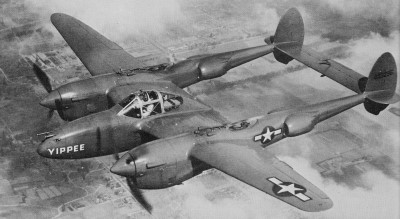 The twin-engined fighter was a phenomenon of
World War II. It offered speed, range, versatility, dependability, firepower and
a host of other wonderful qualities. But it had one major flaw: it didn't work very
well. The twin-engined fighter was a phenomenon of
World War II. It offered speed, range, versatility, dependability, firepower and
a host of other wonderful qualities. But it had one major flaw: it didn't work very
well. The Germans tried it with the Messerschmitt 110, and the RAF Spitfires
and Hurricanes quickly covered the English countryside with pieces of them. The
British tried it with the Mosquito, which worked, but the Mossy was supposed to
have been a light bomber. The Japanese tried it with several impressive machines
but were too late. Of all the enthusiastic efforts, Lockheed's P-38 Lightning
probably came the closest to success, although it suffered from some of the same
drawbacks as did the others, mainly a lack of maneuverability due to size. With
a wingspan of 52 feet and empty weight of more than 14,000 lbs., it dwarfed the
Focke-Wulf 190 (span 34 1/2 feet, empty weight 7000 lbs.) and the Zero (span 36
feet, empty weight 4000 lbs.).
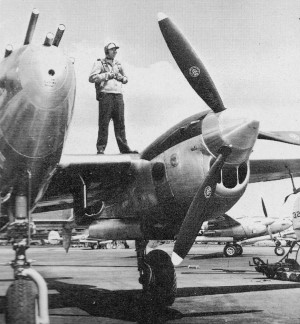 Biggest advantage of the P-38 was a center pod
configuration which allowed concentrated firepower without converging fire.
 By World War
II, a fighter's cockpit was a far cry from the simple instrumentation of WW I. Almost
10,000 Lightning fighters were built.
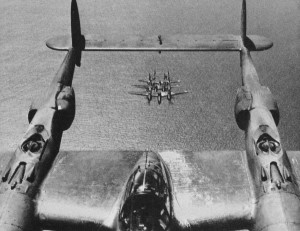 Twin tail booms allowed excellent streamlining
of the engines while eliminating a useless rear fuselage. Note the turbosupercharger
on the top of each boom. Twin tail booms allowed excellent streamlining
of the engines while eliminating a useless rear fuselage. Note the turbosupercharger
on the top of each boom.
But for all its size, the Lightning did practically every job assigned to it with
a high degree of effectiveness. To make up for its limited maneuverability, it offered
outstanding diving and climbing speed, very heavy concentrated firepower, and the
safety of an extra engine. It was the first American aircraft to shoot down an enemy
plane after the U.S. entered the war, and it was the first American aircraft to
land in Japan after it was all over. Almost 10,000 were built, and they did just
about everything that a military airplane can do. The story began in 1937,
when the USAAC announced its interest in a high-altitude interceptor. Convinced
that no single available engine would produce the needed power, Lockheed's chief
designer Hal Hibbard decided to use two of the brand-new 1000-hp, V-12 Allison V-1710
engines. After considering all sorts of arrangements, the veteran firm picked the
twin boom set-up because the center pod would allow a group of guns to be aimed
directly ahead instead of with converging streams of fire, and the booms would allow
excellent streamlining of the engine nacelles without the need for a bulky and useless
rear fuselage. Construction began in June, 1937, and the extremely radical
fighter was rolled out for its first flight in January, 1939, almost three years
before the U.S. entered the Second World War. Just two weeks after the first test
flight, Lockheed jolted the country with a cross-country dash from California to
New York in seven hours, including two stops for fuel. Despite its size and the
fact that its test program had hardly begun, the P-38 cruised near 400 mph, at a
time when the USAAC's main pursuit plane, the Curtiss P-36 Mohawk, could barely
top 300 mph. Even though the prototype was washed out when it hit a ditch
on landing at the end of its sensational speed run, 13 YP-38's were ordered for
tests. Before that order had been completed, the situation in Europe had become
so serious that 66 more were ordered and the P-38 was on its way. Its competitors
in the USAAC competition for a fast interceptor had flopped. The runner-up Grumman
XP-50 (similar to the F5F Skyrocket) crashed on its first flight, while Bell's radical
twin-pusher FM-1 Airacuda lacked all sorts of important qualifications. The P-38, the first really modern fighter ordered by the Army, featured efficient
turbosuperchargers buried in the tail booms, opposite-rotating propellers to counteract
torque and P-effect (a technique first used in the Wright Flyer, but somehow forgotten),
and generally superb streamlining. More important was its so-far-unrealized potential
to accept an amazing variety of modifications without slowing down. The interceptor
was about to become a fighter, a bomber, a photoplane, a cargo and troop transport,
an air ambulance and a glider tug. When the U.S. entered the war,
fewer than 75 P-38's were on hand, but at least they were in production, while the
other types which were to play such important roles - the P-47 and P-51 in particular
- were still being tested. The only other fighters then being built for the Army
were the Bell P-39 and the Curtiss P-40, neither of which was up to the standards
of performance being set in Europe by the Messerschmitt and Focke- Wulf, or in the
Pacific by the Zero. The first really combat-ready P-38 to be delivered
was the P-38D, the first of which appeared in August, 1941, with four .50 cal. machine
guns and a huge 37 mm. cannon in the sleek nose. This model was quickly followed
by the P-38E which carried a smaller 20 mm. cannon and thus set the pace for all
those which were to follow. A low point in the history of the Lightning was reached
when the first one ordered by the RAF arrived in England. Lacking the turbosuperchargers
and the opposite rotations of the propellers, its performance was understandably
poor, and the airplane was rejected and sent home. Not until late
1942 did the airplane hits its stride with the P-38F, first model to see action
in quantity. Power of its Allison engines had been increased from 1150 hp to 1325
hp, raising the top speed firmly over the 400 mph mark. Versatility now came into
the picture. With drop tanks, its range stretched well over 2000 miles. With the
streamlined tanks removed, it could carry 2000 lbs. of bombs. With all armament
removed and cameras installed, it became the world's fastest, longest ranging reconnaissance
airplane. Dog-fighting was not the Lightning's specialty, yet it had
its greatest success in the Pacific against the light, maneuverable Japanese aircraft.
Its concentrated guns simply overwhelmed the lightly built and poorly protected
Japanese fighters and bombers, and its great ability to climb and dive enabled it
to break off the battle whenever it was in danger of being out-maneuvered. Its finest
hours came in service with the 5th Air Force during the island-hopping campaign
to clear out the strings of enemy bases. The two top American aces of the war -
Richard Bong with 40 kills and Thomas McGuire with 38 - both flew P-38s with the
5th AF. As long-range P-47's and P-51's gradually took over the escort
duties of the P-38, other tasks were created for it. The graceful curves of the
fighter nose were replaced by the awkward lines of the hastily created "droop snoot"
versions which carried a navigator on special long distance missions, or a bombardier
to do the precision work for a large formation of standard P-38's. Others carried
special large tank-like containers under the wings, in which not only spare parts
but ground crews were transported. Similar pods were used to carry a pair of stretcher
cases, each, in the ambulance version. As radar became more effective,
the night fighter grew in importance and all sorts of modifications to standard
types were hurried along. One of these was the two-seat night-fighting P-38M, with
a bulge in the rear part of the canopy to clear the head of the radar operator,
and a bomb-like radar device hanging under the nose. It looked awful, but worked
well and flew almost as fast as the clean versions. This was the final modification
of the P-38 to see action. When the war ended, the P-38 continued
on, though in a somewhat what changed role. Hundreds were placed on sale as surplus
for the disgustingly low price of $1500 for a low-time, late-model Lightning. More
were sold to returning GIs than any other type of fighter because of their reputation
for doing so many things well. No fewer than 19 showed up for the 1946 Cleveland
Air Races, 15 of them starting in the Bendix Transcontinental Race from Los Angeles,
and four entered in the pylon events. They were expected to shine in the 2000-mile
Bendix, but Mustangs took the first four places. They weren't expected to do much
around the pylons, because of their size, but Lockheed test pilot and pre-war racer
Tony LeVier beat all the Mustangs to finish second in the classic Thompson Trophy
Race. He was at Cleveland mainly to do a sensational aerobatic routine in his P-38L
which foreshadowed by many years Bob Hoover's great single-engined and dead-stick
work in the Shrike Commander. Others bought P-38's for more practical
reasons, and the type was common for many years throughout the Americas as a high-altitude
photo-mapping aircraft. One occasionally still sees them in the classified ads of
Trade-A-Plane, but time has a way with old airplanes, and the newest P-38 is now
more than 25 years old. Still, there are a few in the air. Two showed up in the
September, 1970, Reno Air Races (N25Y and N38LL) and a third in the California 1000
race at Mojave in November, and there is one up around Seattle which flies in shows.
If you want to take a close look at a Lightning, there are P-38L's
in the USAF Museum in Dayton, Ohio; Harrah's Museum in Reno, Nev., and Ed Maloney's
Museum in Ontario, Calif. The Confederate Air Force has a P-38L with P-38H nacelles,
while the Smithsonian has a P-38J in storage.
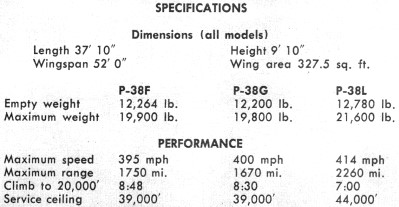
Specifications and Performance
VERSIONS AND VARIANTS
- XP-38 - prototype first flown Jan. 27, 1939
- YP-38 - 13 service test-built, 1940-41; first one flown Sept. 16, 1940
- XP-38A - 1 production model with pressurized cabin, converted in 1941
- P-38B - never built
- P-38C - never built
- P-38D - first production version; 36 built in 1940-41
- P-38E - 210 built in 1941; P-38D with modified armament
- P-38F - first major operational version; 527 built in 1941-42
- P-38G - similar to P-38F; 1082 built in 1942
- P-38H-increased bomb load; 601 built in 1942-43
- P-38J-first version with large chin scoops; 2970 built in 1943
- XP-38K - 1 P-38J with larger propellers, modified in 1943
- P-38L - 3923 built in 1943-45; 1887 more cancelled at end of war
- RP-38 - at least one built with second cockpit on left tail boom
- TP-38L - two·place trainer
- P-38M - 75 P-38L's modified into two place night fighter
- XP-49 - experimental high-altitude version with pressure cabin, 1350 hp Continental
XIV-1430 engines
- F-4 - 99 P-38E's converted to camera planes in 1942
- F-4A - 20 P-38F's converted to camera planes in 1942
- F-5A - 181 P-38G's converted to camera planes in 1942
- F-5B - 200 P-38G's converted to camera planes in 1943
- F-5C - 128 P·38H's converted to camera planes in 1943
- XF-5D - 1 two-seat F-5A
- F-5E - 705 P-38J's and p-38L's converted to camera planes in 1944
- F-5F - P-38J's converted to camera planes in 1944
- F-5G - P·38L's converted to camera planes in 1945
- P-322 - Lockheed factory designation for early P-38
- Lightning I - 143 built for RAF; re· turned to U.S. for training
- Lightning II - 524 intended for RAF, but never delivered; similar to P-38G
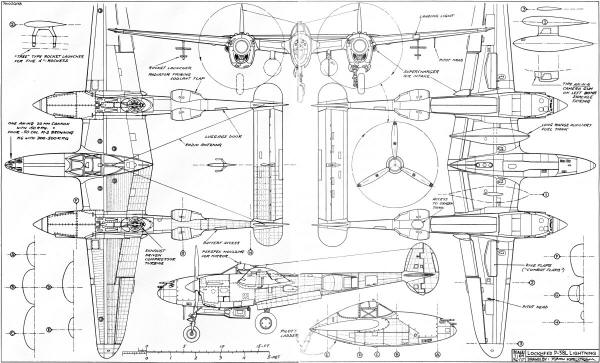 P-38 4-View
<click
for larger version>
Björn Karlström Drawings:
Posted April 28, 2012
|